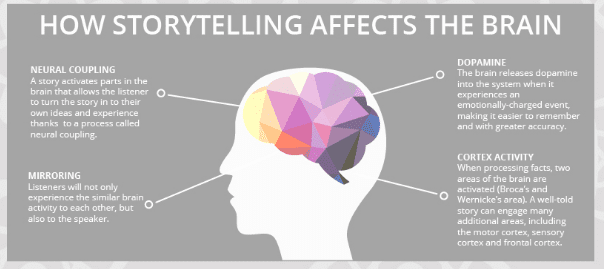Brand storytelling examples showing how a successful brand story takes consumers on a hero’s journey
No one’s heart is wooed by product capabilities and financials alone. What you need is a good story — it’s the key to making your brand a living, breathing thing. Investors, employees, and consumers will rally around a story, and the best business leaders understand that storytelling has the power to change minds and spark action.
Take High Brew Coffee, for example. Its story could easily have been about its product: canned cold-brew coffee. But that’s not very original, and it certainly doesn’t capture the imagination. Instead, High Brew’s story is all about adventure — founder David Smith was inspired to start the business after enjoying cold-brew coffee during warm nights navigating the Caribbean on a sailboat with his family.
When investing in content marketing, it’s necessary to go beyond describing what a company does to sell its brand. You don’t want to be another voice in the cacophony of noise. Rather, you must create value with your content, and you need to engage, entertain, and inform your audience. In other words, tell a story that provides the fundamental purpose and intention for present execution, as well as the framework for a future road map based on your vision.
The good news is that storytelling is now easier than ever. Thanks to a multitude of far-reaching technology platforms and social media, there are so many ways to connect with people. This has changed the traditional notion of content marketing from simply B2B articles and splash pages to a plethora of creative opportunities to reach potential customers.
Storytelling as a Sales Tactic
It may seem counterintuitive for those who value a pushy sales-oriented marketing strategy, but storytelling as content marketing gently pushes your customer down the sales funnel and prepares her to make a purchase she is comfortable with and fulfilled by.
Take a look at the community-driven transportation service Lyft. Just like its competitors, Lyft connects users with drivers in their area to get them from point A to point B. But their content sets Lyft apart from its competition: It supports a positive and human-conscious story that showcases community. By speaking to consumers and drivers like a friendly neighbor would, the brand nurtures users down the funnel. When someone needs a ride, Lyft is already associated with positive feelings and fulfillment.
Storytelling appeals to consumers on an emotional level because it positions them in the center. This is far more powerful than just appealing to their minds. In a brand story, your consumer is the hero — not you. Your story is about your consumers’ emotions and their needs. It talks about ways their lives are difficult, and it addresses real pain points they suffer. Good storytelling connects your brand with your consumers’ needs in a way that fosters trust, builds a community around your identity, and establishes loyalty.
GoPro, for instance, is all about helping consumers capture and celebrate their meaningful, exciting, daring experiences. Its brand stays away from navel-gazing and instead puts all focus on its consumers. A letter from GoPro’s CEO illustrates the concept beautifully:
“Like how a day on the mountain with friends is more meaningful than one spent alone, the sharing of our collective experiences makes our lives more fun. The world’s most versatile cameras are what we make. Enabling you to share your life through incredible photos and videos is what we do.”
Once you understand the power of appealing to your customers’ emotions and placing them at the center of your brand story, you can achieve market penetration, scalable growth, and satisfied customers. When you focus on your consumers (and target the practical and aspirational ways you can improve their lives), you can begin to understand how to relate to them with your story.
Crafting an Irresistible Story
Creating a compelling narrative won’t happen overnight, and it’s important to get it right.
I rely on tried-and-true literary theory and use the mythic hero’s journey as a framework. One of the best ways to tell a story is by considering how your consumers fit in as the main characters. You can map how your characters move through their setting or the context behind why your product exists.

As you better understand your consumers as characters and the world they live in, you will begin to see their challenges and motivations (two key storytelling components!) that will lead your product to be the perfect solution for them. By identifying the challenges in your characters’ world, you will home in on the pain point your product is solving, as well as how they are motivated to overcome it.
Just as any good hero in a story needs a trusty sidekick or magic wand, your product should be the go-to answer for your customers’ problems — like a fairy godmother, genie in a bottle, or Cinderella’s shoe, it should perfectly coincide with the climax of the story. Effective storytelling will guide your brand to this critical moment, and you’ll be well-positioned to be part of your consumer’s continued personal narrative.
Ultimately, storytelling doesn’t make a brand — there’s much more to it. You’ll also need a killer team, an incredible product or service, a go-to-market strategy, and a whole lot of optimism to get you through the hard times. But at the end of the day, a brand with a strong story will persevere.

Thanks to Erin for sharing her advice and opinions in this post. Erin Berman is an established storyteller and brand strategist. From Silicon Valley startups to multinational corporations, she works with companies looking to grow, scale, and tell stories effectively. As founder of
Blackbeard Studios, a digital marketing agency, she lives and breathes storytelling. She has consulted for dozens of startups, taught marketing workshops, and served as advisor and investor at VCs in the Bay Area and abroad. She holds a master’s in creative writing from the University of San Francisco.




 Thanks to Erin for sharing her advice and opinions in this post. Erin Berman is an established storyteller and brand strategist. From Silicon Valley startups to multinational corporations, she works with companies looking to grow, scale, and tell stories effectively. As founder of
Thanks to Erin for sharing her advice and opinions in this post. Erin Berman is an established storyteller and brand strategist. From Silicon Valley startups to multinational corporations, she works with companies looking to grow, scale, and tell stories effectively. As founder of 



